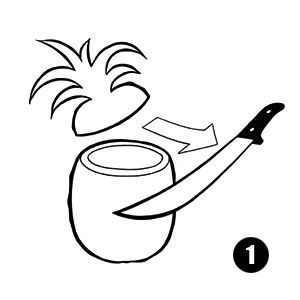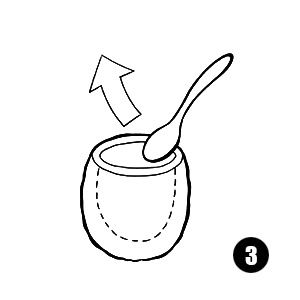I’m embarrassed it’s taken me this long to make a drinking vessel out of a pineapple.
It really should have happened long before now. I’ve been fiddling with tiki-style drinks for well over a year, and I regularly buy whole pineapples, so it’s not like I don’t have them lying around. I’ve also attended at least a dozen Jimmy Buffett concerts, where unorthodox beverage containers abound (lawn flamingos, beer mugs made of a single piece of ice, etc.), so I really should have gotten on the stick by now.
After noticing one of the recipes in Jeff Berry’s Sippin’ Safari could be served in a pineapple, I decided to finally take the plunge. The first step was determining if there was a tried-and-true technique for transforming a large piece of fruit into a fun and functional drink container.
Turns out there isn’t one. Or more accurately, I couldn’t find one. The first thing I did was to contact some of the big brains in the booze nerd community and see what they do. I was surprised to find that most of the people I spoke to hadn’t yet attempted it, and the responses from those who had essentially boiled down to “Cut the top off, and scoop out the insides.”
I also did a little poking around on the web, but that was slim pickings too. There’s a promising-looking gadget designed specifically for taking the guts out of a pineapple, but the reviews were mixed. It appeared that I was headed for trial-and-error territory.
Now I’m the kind of person who doesn’t like to make things more complicated than they need to be, so I stuck close to the “cut off the top and scoop out the insides” method . I’ve made many jack-o-lanterns over the years, so my reasoning was that this would probably be pretty much the same, albeit on a smaller scale and with contents you’d actually want to eat.
I discovered that things shook out to be basically a three-step process:

1) Slice off the top. I cut horizontally about 1.5 to 2 inches below the leaves. If you want a wider, shorter cup, just make your cut farther down. I used my trusty Chinese vegetable knife, but feel free to use the cutting tool of your choice (machete, katana, chainsaw, etc.)

2) Outline a cavity. Run a small knife (I found a grapefruit knife works well) in a circular path near the outside of the pineapple. I recommend you don’t make this cut right up against the rind. Leave at least a half-inch of “meat.”- It’ll add strength to the cup once it’s hollowed out.
Also, this is the step when you’ll discover pineapples are surprisingly soft. Despite their rough exterior, they’re very easy to puncture. I immediately put a hole in mine even though I was trying to be as gentle and deliberate as I could.

3) Shovel out the insides. I used a stainless steel salad spoon, but any rigid, scoop-like implement without sharp edges or corners will probably do the trick. The core in the center will give you the most resistance, but you can use your small knife from step 2 to carefully carve out any stubborn bits.
Like step 2, there’s a bit of guesswork involved here. Just make sure you don’t scoop too deep or too close to the sides, otherwise you‘ll be creating an organic dribble glass.
Optional step: If you want to keep the top to use as a lid, just cut a small notch in the edge for a straw and replace it. You can fasten it to the bottom with a toothpick or cocktail umbrella.
As for the drink itself, I went with the Pina Paradise, from the aforementioned Sippin’ Safari.
Pina Paradise
½ oz. Fresh lime juice
½ oz. Grapefruit juice
½ oz. Orange juice
1/4 oz. Sugar syrup
¾ oz. Gold Puerto Rican rum (I substituted Cruzan)
¾ oz. Martinique rum (I used St. James Royal Ambre)
2 one-inch-square chucks of fresh pineapple
Dash Angostura bitters
6 drops (1/8 teaspoon) almond extract
Place in a blender, without ice, and blend at high speed until pineapple is liquefied. Pour into a cocktail shaker half-filled with ice cubes. Shake well, then pour into a hollowed-out pineapple or tiki mug.
It’s not bad. The rums come through pretty well (especially the Martinique) despite the number of other ingredients. The grapefruit, orange, pineapple and lime do well as a fruit base, and the almond extract is a nice touch- Although I may have to make this again and see what happens if I substitute orgeat.
Overall, it’s a tasty but not particularly remarkable drink. I found it a bit flat, but the Bamboo Babe loved it, so I’ll keep it in the rotation. But in the future, when I’m making another pineapple cup, I’ll likely opt to fill it with a Painkiller or something with a bit more oomph.
To wrap up, here’s a breakdown of my pros & cons for drinking out of a pineapple:
Cons:
Expense. Where I live, whole pineapples run between 4-5 bucks apiece. That can easily be a prohibitive cost depending on how many people you’re serving.
Labor. The time you spend making the cup detracts from time you can be drinking.
Flavor Factor. Whatever drink you put in the cup will be flavored with pineapple to some degree.
Weight. Even a hollowed-out pineapple can get a little heavy and unwieldy after a while.
Pros:
No-Slip Grip. The rind of a pineapple is a natural high-friction surface. If you drop it, it’s not the pineapple’s fault- you probably should have stopped two drinks ago.
Environmentally Friendly. Pineapples are biodegradeable, so when you’re done, compost it, chuck it in the woods, or simply drop it through the sunroof of your snooty neighbor’s Mercedes.
Edible. You can eat what you’ve hollowed out.
Style Factor. I mean, you’re drinking out of a pineapple…how cool is that?
So give it a shot- It’s not as tough as it might look, and it’s a heck of a lot of fun. And as always, tips, advice, cautionary tales, etc., are welcome.


